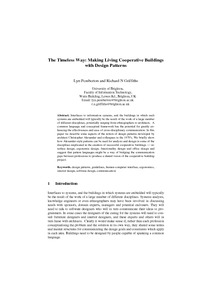The Timeless WayMaking Living Cooperative Buildings with Design Patterns
Lyn Pemberton, Richard N. Griffiths
Publikationsdatum:
Zu finden in: Cooperative Buildings: Integrating Information, Organization, and Architecture (Seite 142 bis 153), 1998
|
 |
 Diese Seite wurde seit 2 Jahren inhaltlich nicht mehr aktualisiert.
Unter Umständen ist sie nicht mehr aktuell.
Diese Seite wurde seit 2 Jahren inhaltlich nicht mehr aktualisiert.
Unter Umständen ist sie nicht mehr aktuell.
 Zusammenfassungen
Zusammenfassungen
Interfaces to information systems, and the buildings in which such systems are embedded will typically be the result of the
work of a large number of different disciplines, potentially ranging from ethnographers to architects. A common language and
conceptual framework has the potential for greatly enhancing the effectiveness and ease of cross-disciplinary communication.
In this paper we describe some aspects of the notion of design patterns developed by architect Christopher Alexander and colleagues
in the 1970’s. We briefly show how Alexander-style patterns can be used for analysis and design in some of the disciplines
implicated in the creation of successful cooperative buildings — interface design, ergonomic design, functionality design
and office design and suggest that pattern languages might be a way of bridging the communication gaps between professions
to produce a shared vision of the cooperative building project.
Von Lyn Pemberton, Richard N. Griffiths im Konferenz-Band Cooperative Buildings: Integrating Information, Organization, and Architecture im Text The Timeless Way (1998)  Dieses Konferenz-Paper erwähnt ...
Dieses Konferenz-Paper erwähnt ...
 Volltext dieses Dokuments
Volltext dieses Dokuments
 |  The Timeless Way: Artikel als Volltext bei Springerlink ( The Timeless Way: Artikel als Volltext bei Springerlink ( : :  , 98 kByte; , 98 kByte;  : :  Link unterbrochen? Letzte Überprüfung: 2021-03-21 Letzte erfolgreiche Überprüfung: 2019-10-11) Link unterbrochen? Letzte Überprüfung: 2021-03-21 Letzte erfolgreiche Überprüfung: 2019-10-11) |
 Anderswo suchen
Anderswo suchen 
 Beat und dieses Konferenz-Paper
Beat und dieses Konferenz-Paper
Beat hat Dieses Konferenz-Paper während seiner Zeit am Institut für Medien und Schule (IMS) ins Biblionetz aufgenommen. Beat besitzt kein physisches, aber ein digitales Exemplar. Eine digitale Version ist auf dem Internet verfügbar (s.o.). Aufgrund der wenigen Einträge im Biblionetz scheint er es nicht wirklich gelesen zu haben. Es gibt bisher auch nur wenige Objekte im Biblionetz, die dieses Werk zitieren.










 design thinking
design thinking Biblionetz-History
Biblionetz-History